Outstanding women in the world of computer technology. Part II

In the last article, we already met some of the outstanding women in the world of computer technology. An important word is - some. Today, we will continue to get acquainted with those who deserve the respect of the scientific community not for beautiful eyes and “outstanding” forms, but for outstanding intelligence and remarkable work. Go.
Margaret Hamilton

')
What can be common between philosophy and mathematics? These two disciplines seem so far apart. When someone chooses one of them, the second one becomes forgotten. However, sometimes even mathematics must be a little philosopher to do great things.
Margaret was born on August 17, 1936 in the small town of Paoli (Indiana). In 1954 she graduated from school in the city of Hancock. In the same year, Margaret entered the faculty of mathematics at the University of Michigan. The choice of such an exact science did not prevent her from obtaining a bachelor's degree in philosophy at Earlham College in 1958. Why mathematics and philosophy, you ask. Mathematics has always interested Margaret, even though there was no one in her family who would study the exact sciences. But the choice of philosophy as a discipline is associated with the influence of her father, who was a poet and philosopher. With regard to the choice of educational institutions - Earlham College - there is also the influence of relatives. The fact is that this college was founded by Quakers (another name is Religious Society of Friends), and grandfather Margaret was a Quaker preacher. This community unites representatives of a wide range of religious beliefs, positioning itself as a place of equality and mutual respect without regard to gender, religious views or other differences. The same principles operated in college, in which both boys and girls could study, which was not so common practice in those times.
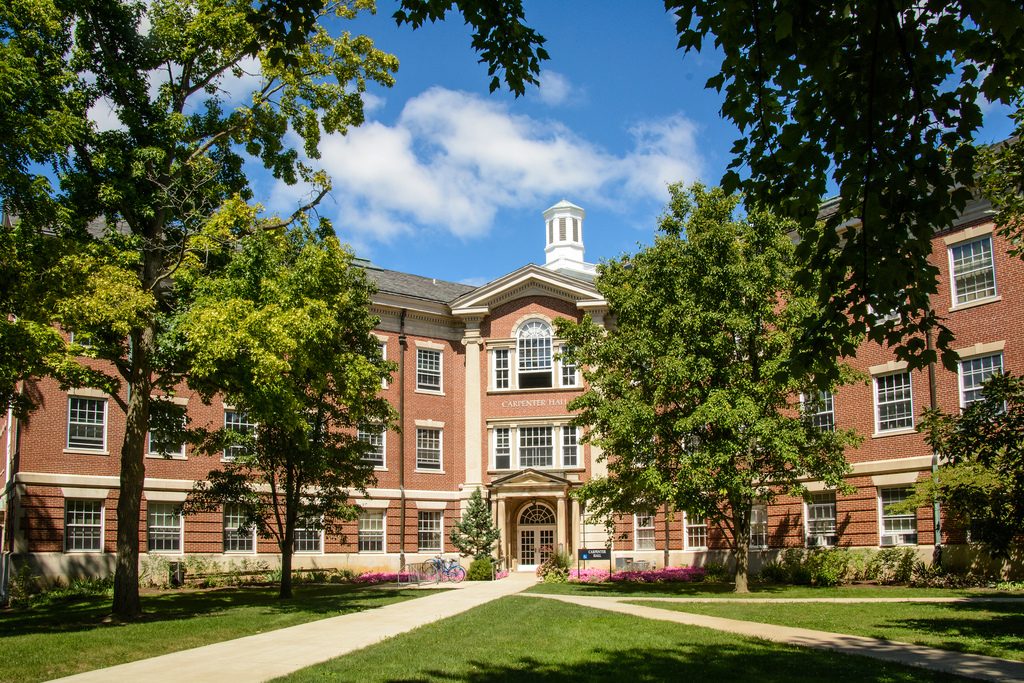
One of the buildings of Earlham College
While still a student, Margaret met her future husband. After marriage, she worked for some time as a teacher of mathematics and French in high school.
As soon as her husband completed the training, Margaret was able to move away from teaching and do more interesting things. In 1960, she began working on writing the weather forecasting software for the LGP-30 and PDP-1 computers, which were part of the MAC project. The actual head of the young programmer was an eminent mathematician and meteorologist Edward Lorenz, who was in charge of the meteorology department at MIT (Massachusetts Institute of Technology). Edward Lorenz is one of the founders of the theory of chaos and the author of the term "butterfly effect", this is if it is very, very briefly to describe his activities. For now it is not about him.
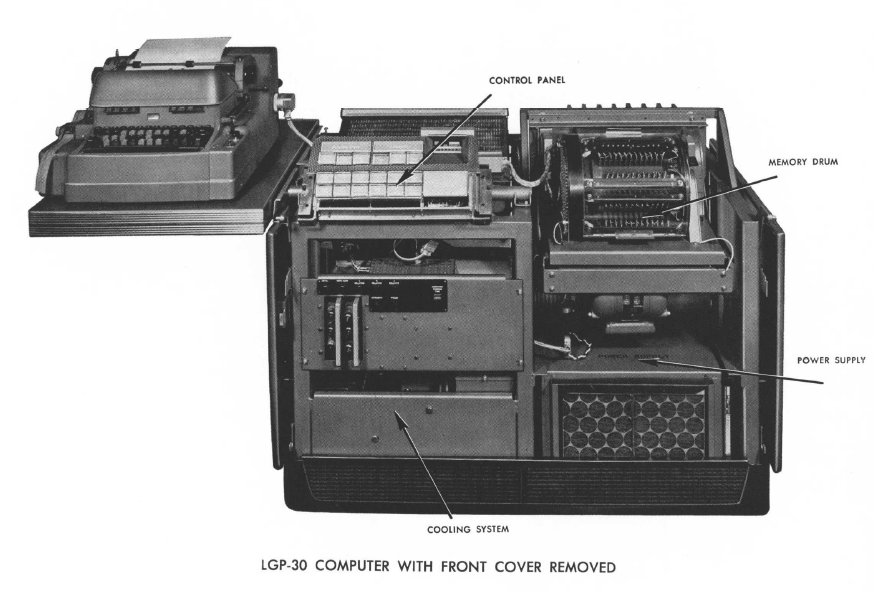
Computer LGP-30 in clear view
From 1961 to 1963, Margaret worked as one of the programmers at the SAGE project at the Lincoln Laboratory (MTI). She created software for the first AN / FSQ-7 computer. Initially, there was the Whirlwind project, whose main task was to predict and track weather conditions through simulations. And the SAGE project was created for military purposes. His task was to track the movement of enemy aircraft in order to anticipate a possible attack by the USSR. It was the period of the Cold War, when many scientific research on both sides were aimed at increasing defense capability against the "enemy".

Margaret in the Lincoln Laboratory (1962)
It was the work on the SAGE project that led NASA to become interested in Margaret and her talents.
Here is what Margaret herself says about the SAGE project:
What was usual when you came to this organization was that the newcomers were allowed to work on this program, which no one really understood and could not launch. When I was a novice, they assigned me to work on it. The programming itself was quite complex, and the person who wrote this program admired the fact that he wrote all the comments in Latin or in Greek. And so I was sent to work on the program and everything worked out for me. She even gave answers in Latin and Greek. I was the first to make it work.After working on the SAGE project, Hamilton joined the team of the Charles Stark Draper Laboratory at MTI, where at that time the Apollo space program was being developed. Very quickly, Margaret led a group of developers who created software for Apollo and the Skylab orbital station.
The most significant contribution to the work of Apollo by Margaret and her team was the software for the onboard computer.
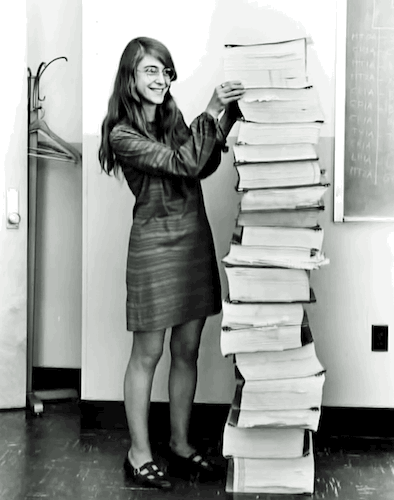
Margaret and the "tower" of the software code for Apollo 11 (1969)
A critical feature of the software developed by the team was a robust architecture, or rather an asynchronous execution of tasks. What this means: the computer will perform first of all the tasks with the highest priority, and then the others. Simply put, if you have a rescue capsule (as in some science fiction), which the life-support system and, for example, the coffee maker refused. The computer will first fix the life support system.
Forget about fiction and my stupid example. In reality, the work of this system was tested for practice. Approximately 3 minutes before Apollo 11 landed on the surface of the moon, the onboard computer began to issue alarms. It was overloaded due to incoming radar data. Thus, the computer had to handle more tasks than physically could. However, thanks to the asynchronous execution system, the computer continued to perform the priority operations that were critical for the moon landing.
Demonstration of the on-board computer Apollo-11
Hamilton's words about the incident are:
The computer (or rather its software) was smart enough to understand that it is being asked to perform more tasks than it is capable of. Then he gave the astronauts a signal “I am overloaded with a large number of tasks than I should perform, therefore at the moment I will execute only the most important ones, i.e. for landing ... ". In fact, the computer was programmed to do more than just identify errors. A complete recovery software package has been implemented in the software. Software actions, in this case, consisted in the elimination of low-priority tasks and the restart of high-priority ones. If the computer would not recognize this error and did not take measures to correct it, I doubt that the landing of Apollo 11 would have been so successful.In 2003, Margaret Hamilton received an honorary award from NASA for her contribution to the development of astronautics. She was nominated by NASA senior technologist Dr. Paul Kerto, who said the following:
I was surprised when I discovered that she was never officially awarded for her incredible work. Its concept of asynchronous software, priority scheduling, end-to-end testing and HITL (Human-in-the-loop), such as displaying priorities, became the foundation for ultra-reliable software.Together with the award, Hamilton received a check in the amount of $ 37,200, which is the largest award amount ever allocated to one person.

In addition to her outstanding work in software programming, Margaret, while working with NASA, tried in every way to convey to the scientific community the importance and complexity of this kind of activity. It was she who first used such a thing as “software engineering”. Until now, this term did not exist, and the activity itself, indicated by it, was not taken seriously. Those who designed “hardware” were considered very important people in any project, and those who did software were just in the pipeline.
Hamilton speaks of it this way:
When I first used this term, no one had heard of it before, at least in our world. It was a long-running joke for a long time. They liked to make fun of me because of my radical ideas. It was a significant day when one of the most respected gurus of hardware explained to everyone during the meeting, agreed with me, that the process of creating software should also be regarded as an engineering discipline, as well as with hardware. Not just for the adoption of a new term as such, but because we deserve its existence in the field of engineering along with others.
Short Interview with Margaret Hamilton
Later Hamilton founded the company Higher Order Software (HOS), where she was executive director from 1976 to 1984. The main task of the company was the development and development of technologies error prevention and fault tolerance. A product called USE.IT was created, based on the methodology developed at HOS. It has been used successfully in many government systems.
The company's work and its brainchild succumbed to both laudatory reviews and harsh criticism. Edsger Dijkstra, a prominent Dutch scientist, called USE.IT "a mechanized means for using outdated methods."
1985 Hamilton left the company, but for a long time did not sit idle. Already in March 1986, she founded the new company Hamilton Technologies, where she took the post of executive director.
Of course, at the mention of the name of Margaret, everyone immediately comes up with her work at NASA. However, she showed herself as an excellent leader and entrepreneur.
Awarding Margaret Hamilton Presidential Medal of Freedom
November 22, 2016 Margaret Hamilton was awarded the Presidential Medal of Freedom, the highest award for a civilian in the United States.
Margaret showed everyone that you can be both a philosopher and a software developer. She had to understand the areas of which very few people knew and certainly no one had ever taught anyone this. Roughly speaking, she had to understand and learn the principles of operation of devices and programs already during their use.
Hedi lamarr
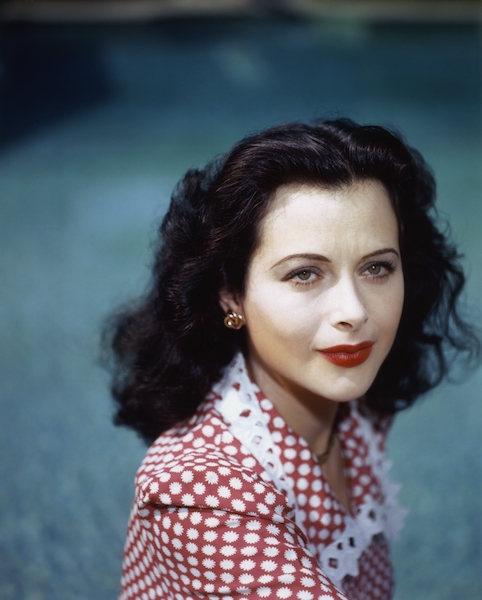
Beauty is a terrible power. And what if beauty has sung with an extraordinary mind? It was such a rattling mixture, beauty and intelligence, that Lady Lamarr possessed.
Hedy was born (originally Hedwig Eva Maria Kiesler) on November 9, 1914 in Vienna. Her family was not burdened with financial problems. My father was a banker, and my mother was a pianist, and came from a fairly wealthy family. Even in her youth, Hedy showed good acting skills. Stubborn character and faith in his talent pushed Khedi to quit school at the age of 15 and completely withdraw into the world of acting.

Hedwig Eva Maria Kiesler at the age of 7
In the late 20s, Max Reinhardt, an Austrian director and theater man, brought her to Berlin, where she started working as a “script girl” at the end of the acting school (in the early years of this profession, only women were engaged in it, and from that name) - the person responsible for many aspects - costumes, scenery, makeup, the actions of the actors during the filming, etc. Subsequently, Hedy became an actress.
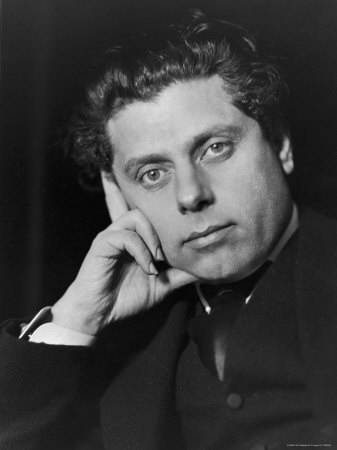
Max Reinhardt
Her great popularity brought her role in the film Gustav Mahata "Ecstasy" (1933). However, not her acting data was on everyone’s lips, but incredibly frank scenes at the time, where Khedi appeared naked. It is said that Hedy herself did not think that her body would be so clearly seen in the frame, but the director and producers did not tell her about using powerful telephoto lenses during filming. As a result, the film caused a storm of mixed emotions among viewers, critics' reviews and the reactions of governments in many countries. Ecstasy won an award at the Rome Film Festival. However, the leaders of the United States and Germany took the picture, to put it mildly, coldly and banned it from showing in their countries. Pope also sharply criticized this film.

Khedi in the film "Ecstasy"
Such an ambiguous role has strongly hurt Khedi’s attitude towards cinema, so she turned her attention to the stage, playing several roles in famous productions.
One of the most persistent, among many, Khedi's gentlemen was Friedrich Mandl. On August 10, 1933, they entered into a marriage that did not last long and was far from ideal. Mandl was engaged in the production of weapons, and therefore led a friendship with the then leaders of different countries. According to Hedy, Hitler and Mussolini repeatedly attended the lush parties that Friedrich held at home.

Friedrich Mandl
Since Mandl was very despotic, Hedy almost all the time had to spend with him. He took her with him to various business meetings where details of the production and development of various weapons were discussed in the company of scientists and weapons manufacturers. It was these meetings that showed in Hedy her interest in applied science, which would later give results.
No longer wanting to endure the tyranny of her husband, Hedy, dressing up in her maid, fled to London, where she was able to achieve a divorce. She was finally free, but had no job. This alignment lasted very long.
In London, Hedy met with Louis B. Mayer, one of the founders of MGM. In order to avoid constant comparison with the role in the movie "Ecstasy", Meier offers Hedy to change the name. She uses Lamarr as a pseudonym (her name was based on the name of the outstanding silent film actress Barbara la Marr).
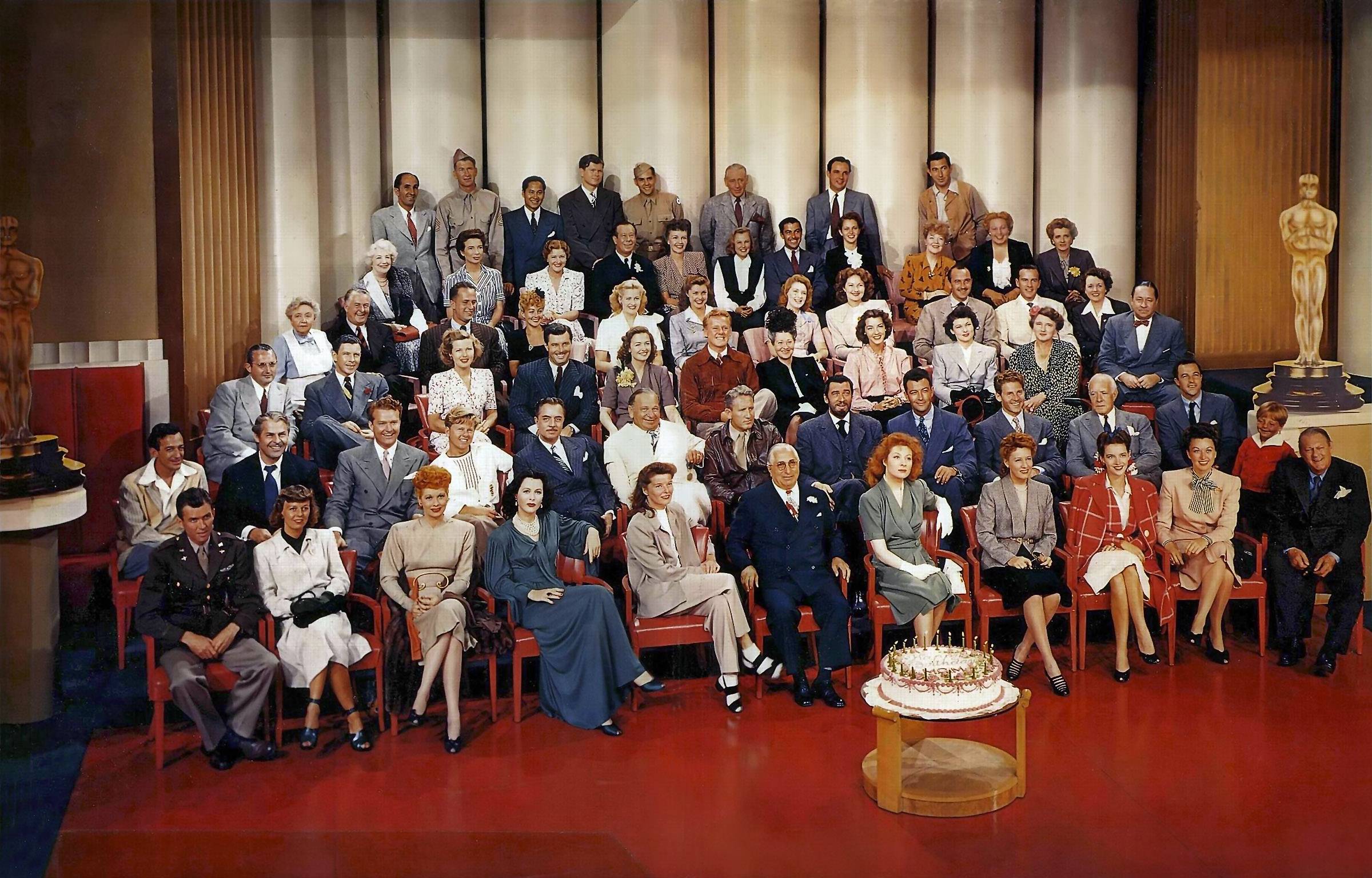
Actors MGM and Louis B. Meyer (first row, center) - 1943
This was followed by a very successful film actress career. Millions of fans, the title of "the most beautiful woman in the world", the recognition, in general, all that the actress can desire.

Hedy in his improvised lab
But Hedy Lamarr is not on this list because of his acting talents. The second, but no less important, Hedy's fascination was inventions. Simply put, she loved to collect and disassemble something, trying to understand the principle of work and possible ways of improvement. Even in her trailer on the set there was a table with all sorts of details, tools and drawings. And at home she had a whole improvised workshop and a huge bookcase with books of different scientific fields. They say that Howard Hughes admired Hedy and as an actress, and as the owner of such an extraordinary mind. He even gave her a set of tools for her hobbies.
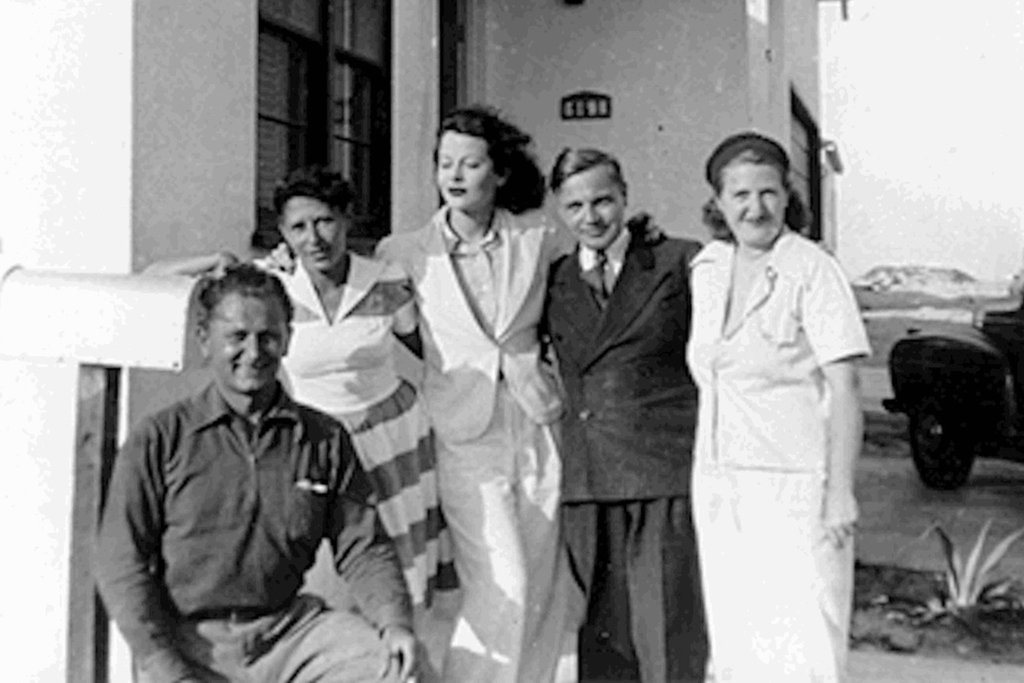
Hedy Lamarr and George Anteil
World War II was in full swing. Hedy Lamarr, a native of Europe and half Jewish, was extremely sensitive to the news of what was happening in her once-home lands. Then she decided that she had to intervene, do something. Her friend and, in consequence, his partner inventions, George Antheil, said:
We started talking about the war, which was especially terrible in the late summer of 1940. Hedy said she did not feel comfortable sitting in Hollywood and earning a lot of money when there is such a situation. She said that she is well versed in armaments and various secret types of weapons .... and that she is seriously considering quitting work at MGM and going to Washington in order to join the newly formed Board of Inventors.One of the biggest problems for the Allied forces was the Nazi submarines. Imagine the situation: the ship of the Allied forces detects an enemy submarine and launches a guided torpedo into it. The problem was that these submarines could intercept and jam the signal with which the ship could control the torpedo. The signal was transmitted at a specific frequency. It is necessary to reveal and drown out this frequency, and that's all, torpedoes are not terrible for you. Hedy Lamarr thought, why not split the signal into different segments and transmit them on several frequencies. Thus, having muffled one frequency, the enemy did not jam the entire signal, and the ship continued to successfully control the torpedo. This process is called the spread spectrum method.

Spread spectrum graphic
And Khedi was able to make this invention, turn it from theory into a real device. On August 11, she and George Antheil received a patent. They immediately went to the leaders of the US Navy in order to present their invention that could change the course of the war. However, they were refused. Someone says because of the complexity of the implementation, they say the military did not want to waste time and resources; Someone believes that Hedy did not trust, suspecting her of spying for the benefit of the Nazis (she is from Europe, whatever one may say). So it was forgotten such an important invention. Forgotten for decades, but not forever.
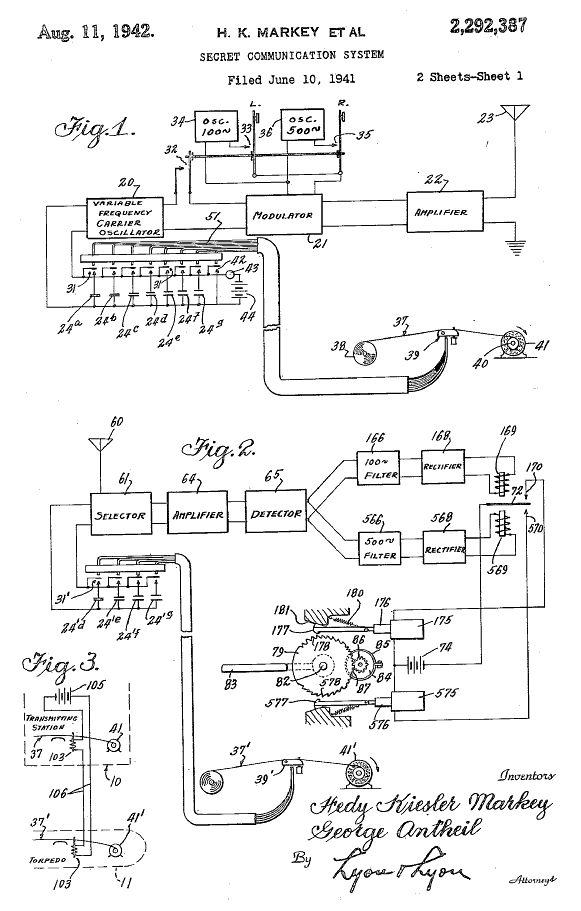
Spread Spectrum Device Patent Page (August 11, 1942)
It was only in 1962, during the time of the Cuban conflict, that an updated version of Lamarr's invention was installed on the ships of the US Navy. However, the inventor herself did not know about it. The whole problem was in US patent laws. The author of the invention and the holder of the patent had the right to dividends from its use only during the period of validity of the patent itself. A quick patent action Lamarr expired in 1959. In fact, she lost her right to her own creation.
Google Doodle in honor of 101 years since the birth of Hedy Lamarr
The official recognition of Lamarr as an inventor, and not as an actress, came already on the slope of her years. In 1997, she received the Pioneer Electronic Frontier Foundation Award, presented to people for her tremendous contribution to the empowerment of people through computer technology. She also received the Bronze Bulbie Gnass Spirit of Achievement Bronze Award, which is given to people who have made significant contributions to the arts, science, business or in the field of invention, which influenced the future life of the whole society.
In 2014, Hedy Lamarr and George Antheal were included in the National Hall of Fame of Inventors.
A documentary about life, work and, most importantly, about science and inventive activity Hedy Lamarr (2017) Warning: pop-up ads, but the film is worth it.
Hedy Lamarr's life was like a movie. There were scandalous roles, and tragic events, and career ups and downs, and the triumph of the mind, and oblivion. Hedy proved to the whole world that one should not appreciate and evaluate a person only by his “cover”. Behind beautiful eyes, an equally beautiful mind can be hidden.
Man's mind is much more interesting than his appearance, I think. People think I'm some kind of stupid girl.Also, Lamarr is an excellent example of what a person should help others with what he can. You can not stand aside, you can not be indifferent, even if no one appreciates your efforts, even if no one remembers them.
Give the world the best that you have, and you will get in the teeth. All the same, give the world the best that you have.
Mary Allen Wilks
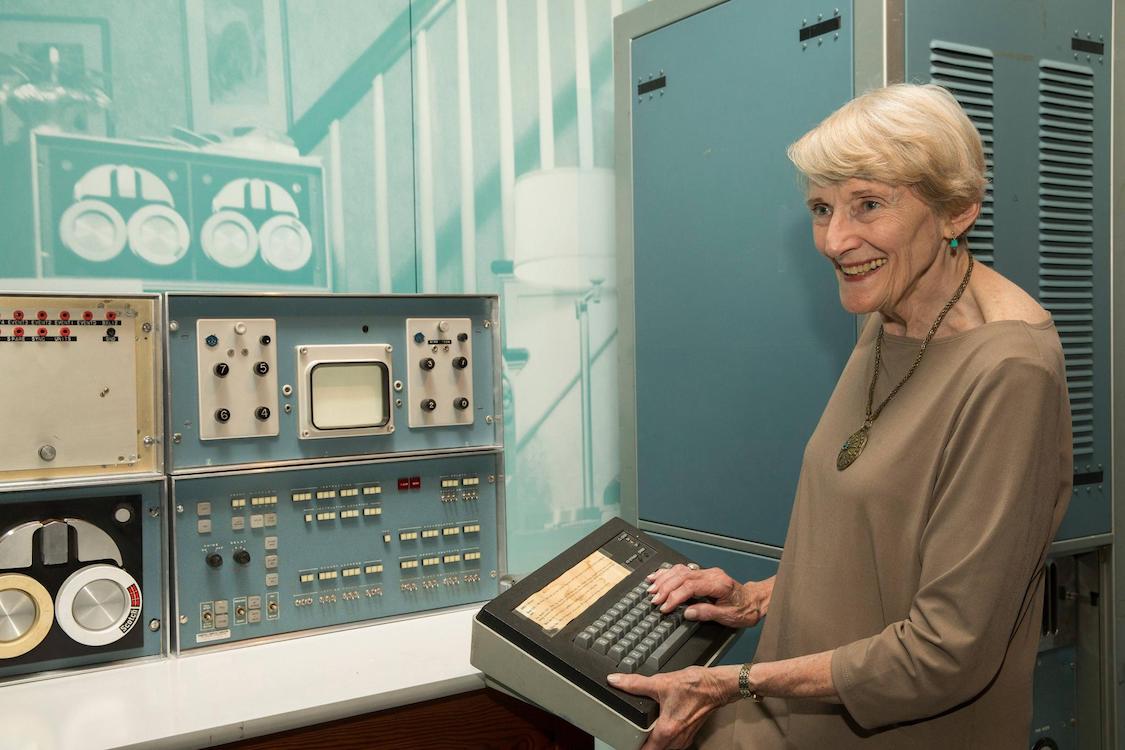
Have you ever asked a curious question - and who was the first person in the world who had a computer at home? So, this man was Mary Allen Wilks. But this is far from the only accomplishment of her in a long career in the field of computer technology and law.
Mary was born on December 25, 1937 in Chicago, Illinois. After high school, Mary entered Wellesley College, where she received a bachelor's degree in 1959. What prompted her to choose computers? According to Ms. Wilkes, when she studied in the 8th grade, the geography teacher told her: “Mary Allen, when you grow up, you must become a computer programmer.” Perhaps this teacher saw her true talents in Mary, and this parting was realized.
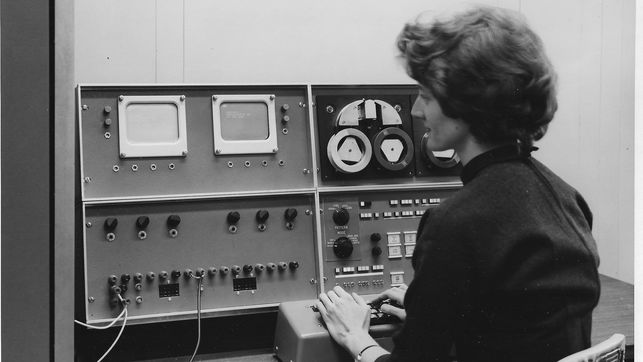
Mary Allen while working on LINC (1962)
From 1959 to 1960, Mary worked at the Lincoln Laboratory at MIT, where she was involved in creating software for the early IBM 704 and IBM 709 computers. Later, in 1961, Mary joined the LINC development team under the direction of Wesley Clark. LINC or Laboratory Instrument Computer was the first microcomputer and progenitor of home PCs. Of course, it was not as compact as modern PCs, but at that time its dimensions were very small compared to other computers. Wilks' main task was to write various operating systems for LINC. Her first creation was called LAP (Line Assembly Program), it was a combination of OS and assembler code. With the help of LAP, a user could choose to write programs in assembly language or machine. LAP was developed and improved up to the LAP6 version, according to which Mary Wilks wrote the user manual.

Mary Allen Wilks at work (1963)
In 1965, Mary programmed not in the laboratory, not at the university, but at home. It was unbelievable at the time. During this period, she created an important element of modern compilers - the linker model.
According to Mary, her parents, especially her father, were very pleased to have a PC at home. Father Mary boasted to all of his neighbors and loved to say in jest:
I bet you don't have a computer in your living room.After working at MIT, Mary worked at the University of Washington in St. Louis in the computer systems lab.

Mary at the computer in the living room of her house (1965)
Working with computers brought a lot of pleasure to Mary, especially since she coped well with her. However, Ms. Wilkes is a versatile person, and does not like to dwell on one thing. In 1972, she left the world of computer science and entered Harvard Law School.
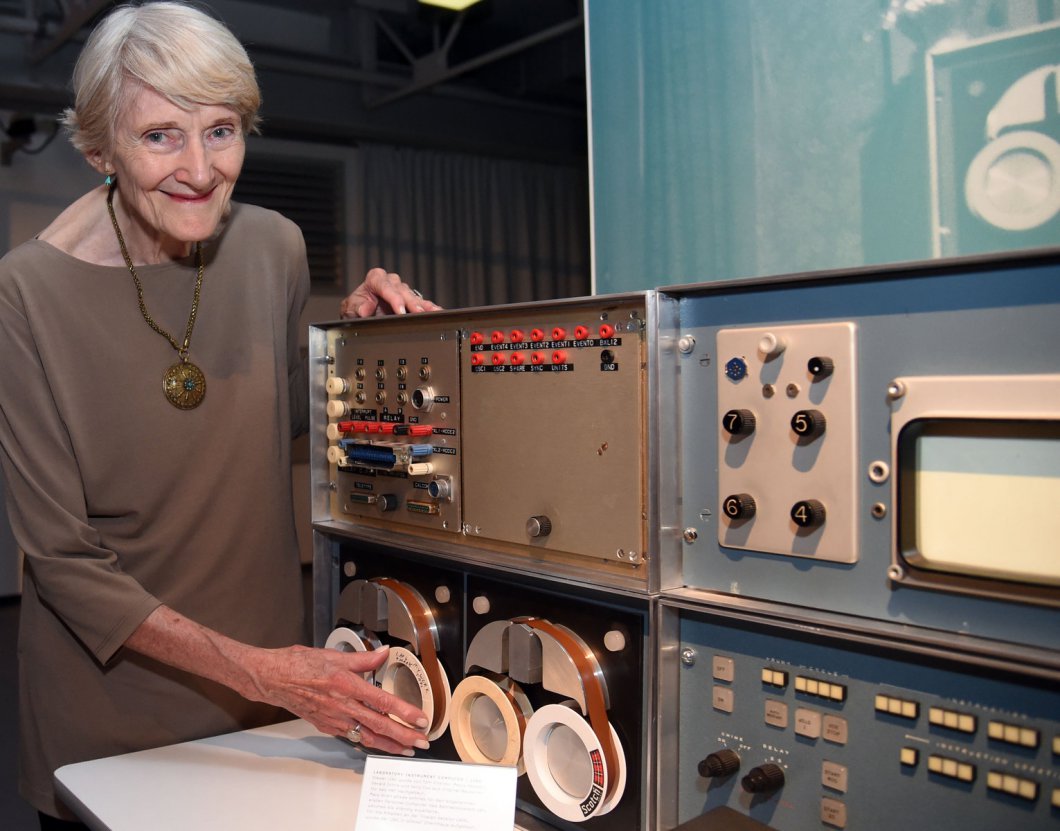
The career of a lawyer for Mary Wilkes was as successful as the career of a programmer. For many years she was a lawyer. Then she led the Economic Crimes and Consumer Protection Division at the district attorney’s office of Middlesex County. From 1983 to 2011, she taught at Harvard. For 18 years, she acted as a judge at the annual Ames Moot Court Competition, a competition among students during which a court session is simulated. In 2011, she became a representative of the American Arbitration Association (American Arbitration Association) - a non-profit organization for resolving disputes between parties who do not want to bring the case to court. Even in this position, Mary had to recall her past with computers, since she was engaged in resolving disputes specifically in the field of information technology and computer science. For 8 years, she was a judge at one of the most prestigious law competitions in the world - Willem C. VIS International Commercial Arbitration Moot (here also participants had to take part in the simulation of the court session), held in Vienna.
Interview with Mary Allen Wilks (2007)
Mary Allen Wilks deserves attention not only as a strong and intelligent woman or as an outstanding programmer and pioneer of home PCs, but also as an excellent lawyer. What can be common in such, at first glance, different sciences? Everything is simple - both in computers and law, success can be achieved only with an extraordinary intelligence and ability to analyze, the ability to see sequences, and foresee the outcome of the work of a particular element.
Gertrude Blanche
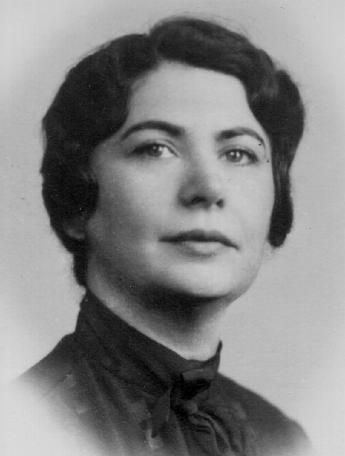
Sometimes, to succeed, it is necessary to go through a difficult path, overcoming obstacles one after the other. The main thing is not to give up and go to your goal, no matter what.
Gertrude Blanche was born on February 2, 1897 in the town of Kolno (now Poland) under the name of Gittel Kaimowitz. In addition to her, there were six other children in the family. Gertrude's father immigrated to the United States, and in 1907 she and her mother followed him. After settling in New York, she began studying at the Eastern District School in Brooklyn, from which she graduated in 1914. Unfortunately, the father of Gertrude died in the same year. Realizing that she would have to feed her family, she postponed plans for getting an education to start working as a simple clerk. Over the course of 14 years, Gertrude put off as much as she could and, finally, entered New York University, graduating in 1932 with a bachelor's degree in mathematics and physics. It was this year that Gittel Kaimowitz changed her name to Gertrude Blanche. Already in 1935 she defended her doctoral degree at Cornell University in the direction of algebraic geometry.
Gertrude's scientific career began, like many, with teaching. However, she had to chew on granite science for a short time; after 3 years, Blanche joined the team of the newly formed Mathematical Tables Project. This organization was the largest and most effective in matters of computing until the creation of electronic computers. It was created based on WPA (Works Progress Administration).

Mathematical Tables Project Office
* WPA - The United States Public Works Administration, created in 1935 by President Roosevelt to provide people with jobs under the new economic course aimed at restoring the US economy after the Great Depression (1929-1939).
Within the walls of this organization, various complex calculations were performed for various projects, government and military structures and for scientific research. In the shortest possible time, Blanche became one of the leaders.
The staff consisted of 450 people, most of whom had only basic knowledge in the field of mathematics. However, the algorithms and methods for detecting errors were so effective that for many decades, the results of calculations determined the standard for transcendental functions.
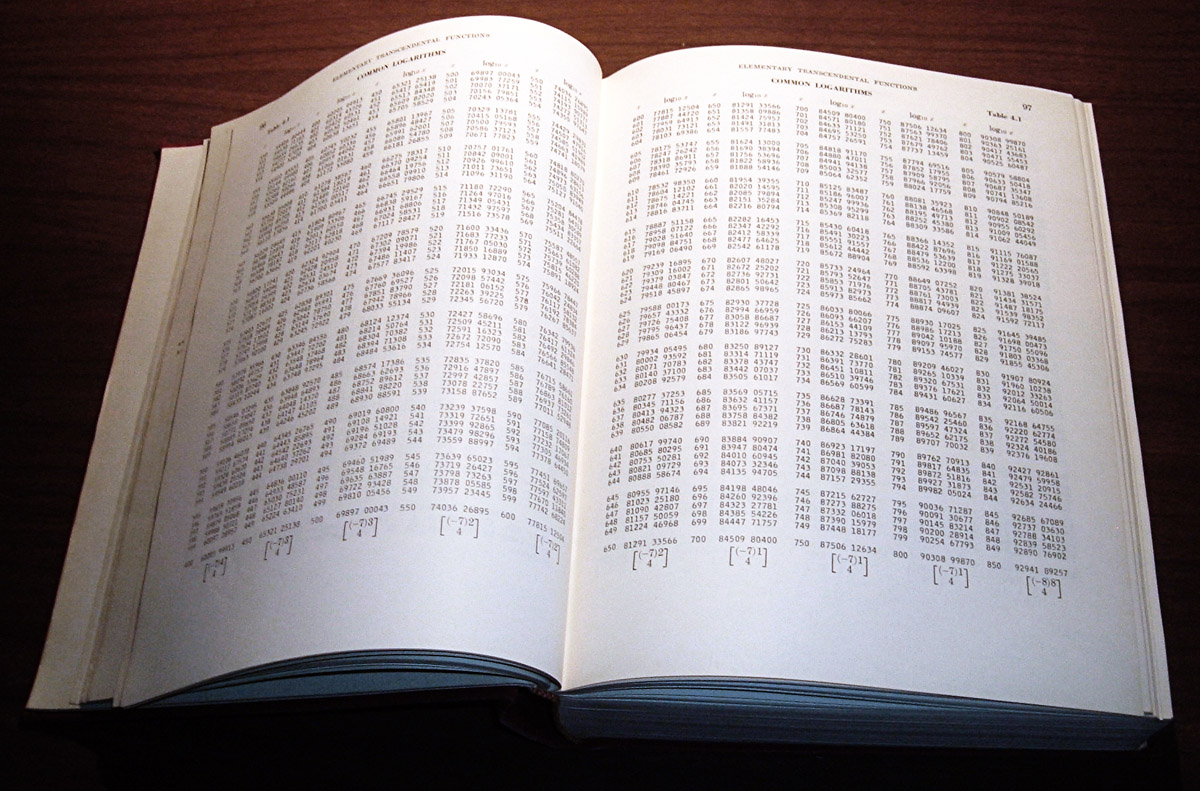
An example of math tables
At the end of 1942, the Mathematical Tables Project disconnected from WPA and became an independent organization. It was the Second World War and the US military needed different kinds of calculations for their weapons, tracking systems and communications, etc. Under the direction of Gertrude Blanche, computational work was carried out for the Bureau of Research and Development, the Navy and even for the Manhattan Project (development of nuclear weapons).
The war was over, and the allies celebrated victory. I think the country's leadership should have thanked the fighters of the invisible scientific front for their merits, but everything went the other way. The FBI (Federal Bureau of Investigation) accused Blanche of being a communist. The arguments to the impossible were stupid: she had no husband and children, and her sister was associated with the communist party. Gertrude was not going to lower her head and agree with the wrongness of the authorities. She demanded a hearing on this matter, in which she successfully proved her innocence.
After passing this difficult stage, Blanche began working at the Institute of Numerical Analysis at the University of California and at the aerospace research laboratory at the Wright-Patterson Air Force Base.

US Air Force Base Wright-Patterson
In 1947, the Computing Technology Association was formed - an international organization in the field of computer technology, one of the first members of which was Gertrude Blanche.
Blanch's works did not go unnoticed, and in 1962 she was elected representative of the American Association for the Advancement of Science, founded back in 1848. The purpose of this organization is to unite scientists, develop science and scientific freedoms, as well as promote scientific research and development.
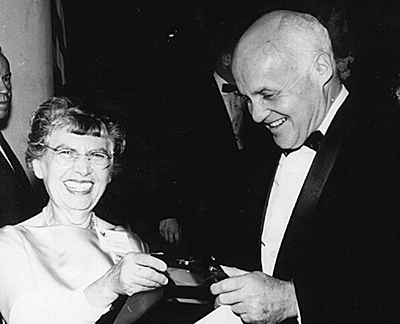
Gertrude Blanche during a dinner party in her honor (1963)
After retirement, in 1969, Blanche did not stop working with brains. Mathematics and computing were her world. She worked on Mathieu's functions, focusing on using continuous fractions in order to achieve the most accurate results with a small number of computational actions.
Unfortunately for the entire scientific community, Gertrude Blanche passed away in 1996, without having published this work.
Gertrude Blanche could boast not only outstanding knowledge in the field of mathematics or excellent leadership and leadership talents, but also a strong spirit. On her way to science, which she loved so much, there were many obstacles that would break a weak person. But she was strong. Strong mind, strong and soul.
Frances Allen

Sometimes the path of fate may not lead a person to exactly where he intended. But not always this new path, a new turn means failure, sometimes it is a lucky break.
Frances Allen was born on August 4, 1932 in Peru, New York, in the family of a farmer and a teacher of elementary grades. Frances was the eldest of 6 children in the family. She spent her childhood on a farm, away from noisy cities. In school, her idol was a teacher in mathematics, who apparently inspired her to the idea of becoming a teacher in this field. After graduating, Frances enrolled at the University of New York at Albany (at that time it was the pedagogical college of the State of New York) where she received a bachelor's degree in mathematics in 1954. She became a master in the same field after some 3 years at the University of Michigan. Among other things, Francis took computer courses where she studied programming on the IBM 650 computer.

IBM 650
Having completed the educational stage of her life, Frances began her career as a teacher in her native town of Peru. However, this did not last long. The fact is that education for Frances was expensive not only in terms of the time and work she invested in it, but also from a financial point of view. In order to pay off tuition fees, Miss Allen in 1957 joined the team of the John Watson Research Center at IBM. Two months before, a new high-level programming language was released - Fortran. The management set a clear task for Miss Allen - to train the research center staff in this language and popularize it among users. Given that Fortran was something completely new, Francis had to learn it himself, picking at the source code of the compiler. On this occasion, she said:
, , .Such a strong interest in compilers could not help but bear fruit. At first, Allen worked on improving compilers for the IBM research center. Namely, over the controlled operating system of automatic debugging.
A significant event in the career of Francis Allen was the work on the IBM 7950 computer, which was called Harvest, and the IBM 7030 Stretch.

IBM 7030 Stretch
IBM 7030 was one of the first supercomputers. And Harvest was a coprocessor (in other words, a special processor increasing the capabilities of the central one). Harvest was designed specifically for the NSA (National Security Agency) to decrypt messages.
The work was difficult, but Allen and her team coped with it perfectly, while creating something new. Namely, a single compiler framework for three programming languages — Fortran, Autocoder, and Alpha (created to quickly detect patterns in random text using any alphabet). A common feature of compilers was an optimizing backend with the ability to generate code for both Stretch and its Harvest co-processor.
When the work on the project was completed, Allen became an IBM representative and curator of the installation and configuration of computers in the walls of the NSA. Harvest / Stretch worked from 1962 to 1976. Serially, this supercomputer was not produced, so the one that was at the NSA was one of a kind.
The success of Harvest / Stretch prompted IBM's leadership to offer Francis work on System / 360. However, this work would require her to travel a lot, because Allen refused. Instead, she rejoined the John Watson Research Center, or rather, “Project Y,” which later became known as the Advanced Computing Systems project.
The project was aimed at improving computer systems. The hardware can be described as the first superscalar processor that could perform more than one task, as its predecessors did, but several at once. It was also possible to perform them in the “wrong” order in order to speed up the process of performing all the tasks.
Compilers have also been revolutionary innovations - flow analysis, allowing the compiler to automatically optimize programs for a significant increase in performance. The point was to present the program inside the compiler, not as a sequence of operations, but as a mathematical graph, which can be analyzed to reveal the hidden properties of the code. For example, the value obtained during the calculation can be used in another part of the code or, on the contrary, it will definitely not be used in another piece of code.
To implement this whole process, the edges of the graph were marked with a mathematical set, after which this set was depicted as an extremely compact data structure (1 memory bit for each element of the set). This made it possible to process data sets very quickly. Thus, the speed of the compiler and the program itself has increased significantly.
Lecture by Francis Allen on “Optimizing Compilers for Parallel Computers” (August 1994)
In the early 70s, IBM decided to start a revolution in the computer world by launching the Future Systems project, aimed at improving systems with modern hardware. Allen was sent to this project, but she believed that the machine architecture was far from perfect and this could severely limit performance. She tried to convey her opinion to the leadership, but no one listened. As a result, the project was closed, having existed for only 4 years.
Frances Allen decided to move away from research and engage in teaching. She began to lecture on compilers to students at the Kuran Institute of Mathematical Sciences at New York University, where she was invited by Jacob Schwartz (the creator of SETL and the computer NYU). People with common views and interests are doomed to be together. This happened to Francis and Jacob, who soon married.
Allen did not stop working at IBM. After a short break, she joined the ECS project (Experimental Compilation Systems). Like the Harvest / Stretch compilers, these also had to work for several languages, but the lion's share of attention was given to the new language PL / I.
The last big project in the career of Francis Allen was PTRAN (Parallel Translator) - a system of compiling Fortran programs for implementation on parallel architectures. The extensive experience of interprocessor flow analysis allowed Allen to create new algorithms for extracting concurrency from the PTRAN serial code, which as a result became known as the “Dependency Graph”, which is still used in many parallelization compilers today.
For a long career, until 2002, Allen received many awards, honorary degrees and well-deserved recognition. Some of them are: 1989 - IBM Fellow (the first woman to receive this title), 1991 - IEEE Fellow (Institute of Electrical and Electronics Engineers), 1994 - ACM Fellow (Computer Association), etc.
* Fellow- in this context, it can be translated as a “member of the scientific society”, an honorary title and position that is received by those who have made a serious contribution to the development of a particular field of activity, in this case computer technologies.
In addition to the above, Frances Allen also became the first woman to be awarded the Turing Prize for her contribution in the field of computer software optimization.
Francis Allen talks about receiving the Turing award and about changes in computer technologies and their impact on people / society and various spheres of their lives.
Francis Allen did not seek to create something new, her main goal was to improve what is already there. However, do not underestimate the significance of this work. After all, we all now know very well from our own experience how pleasant it is when a program is running faster and more efficiently. After all, no one wants to waste time in vain.
Epilogue
What epithet comes to mind after reading the stories of the above women? Brilliant. Each of them showed the world its strongest side - its own mind. Overcoming many problems, literally punching their way to the world of science, they deserved their place among the best of its representatives. First of all, they are scientists, researchers, inventors and thinkers. Not for nothing they say - they meet on the cover, but they see off the mind. So, all of them should be “escorted” with applause.
Thank you for staying with us. Do you like our articles? Want to see more interesting materials? Support us by placing an order or recommending to friends, 30% discount for Habr users on a unique analogue of the entry-level servers that we invented for you: The whole truth about VPS (KVM) E5-2650 v4 (6 Cores) 10GB DDR4 240GB SSD 1Gbps from $ 20 or how to share the server? (Options are available with RAID1 and RAID10, up to 24 cores and up to 40GB DDR4).
Dell R730xd 2 times cheaper? Only we have 2 x Intel Dodeca-Core Xeon E5-2650v4 128GB DDR4 6x480GB SSD 1Gbps 100 TV from $ 249 in the Netherlands and the USA! Read about How to build an infrastructure building. class c using servers Dell R730xd E5-2650 v4 worth 9000 euros for a penny?
Source: https://habr.com/ru/post/374371/
All Articles